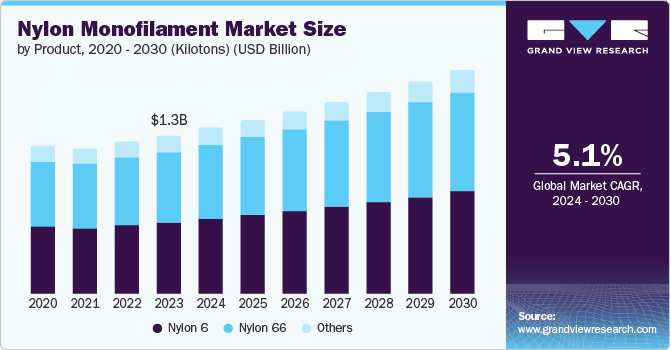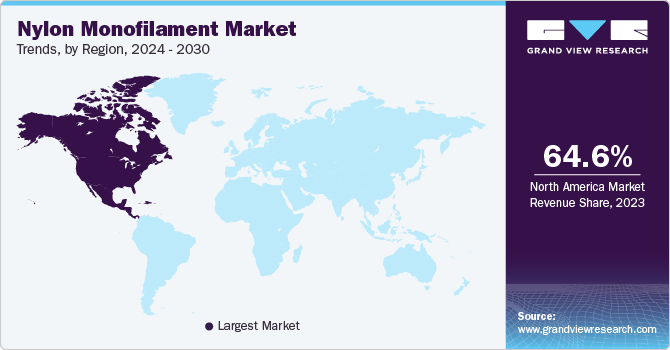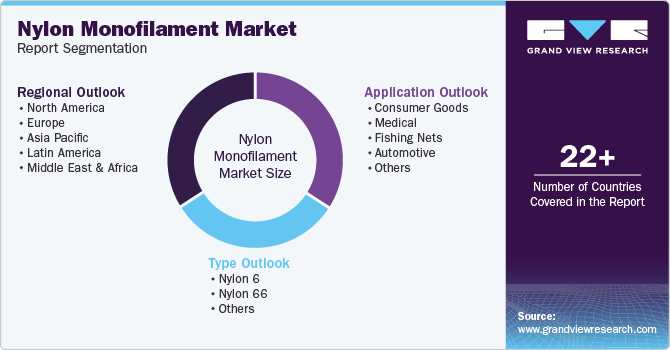- Home
- »
- Plastics, Polymers & Resins
- »
-
Nylon Monofilament Market Size And Share Report, 2030GVR Report cover
![Nylon Monofilament Market Size, Share & Trends Report]()
Nylon Monofilament Market Size, Share & Trends Analysis Report By Type (Nylon 6, Nylon 66, Others), By Application (Fishing Net, Medical, Automotive, Consumer Goods, Others) By Region, And Segment Forecasts, 2024 - 2030
- Report ID: 978-1-68038-364-5
- Number of Report Pages: 100
- Format: PDF, Horizon Databook
- Historical Range: 2018 - 2022
- Forecast Period: 2024 - 2030
- Industry: Bulk Chemicals
Nylon Monofilament Market Size & Trends
The global nylon monofilament market size was valued at USD 1.33 billion in 2023 and is projected to grow at a CAGR of 5.1% from 2024 to 2030. Nylon monofilament is a single, continuous-strand filament made of synthetic fiber. It has higher melting points compared to polypropylene and is typically extruded at temperatures between 260 and 270 degrees Celsius. The demand for nylon monofilament in the global market is mainly driven by the growing agriculture sector, where it is widely used as a nylon fishing line. Nylon monofilament is also widely used in the production of fishing nets due to its low cost and durability.

With the growth of the fishing sector and increasing demand for fish, the demand for nylon monofilament is expected to upsurge in the forecast period. According to the Biannual Food Outlook of the Food and Agriculture Organization of the United Nations, the average per capita seafood consumption is projected to reach 21.4 kg by 2030, further contributing to the demand for fishing nets. Furthermore, the increasing usage of nylon in consumer goods and the significant growth in demand are expected to support the market growth of nylon monofilament. Its applications in the medical industry, particularly in countering diabetes, are also anticipated to contribute to the global nylon monofilament market.
The market growth is anticipated to be primarily driven by the increasing use of nylon in medicinal applications, mainly in treating diabetes. The overall demand for nylon monofilament is projected to rise due to factors such as the aging population, increasing demand for fish food, and the automotive sector. These versatile products find applications in various sectors, including consumer goods, the medical field, the automotive industry, the paper market, and the textile industry.
In addition, the demand for nylon monofilaments in the mechanical textiles, garden, and commercial industries is expected to fuel the market's growth. The market expansion is anticipated to be driven by the rising demand for sports equipment due to the quick commercialization of racket sports. Furthermore, aromatic nylon-based three-dimensional textile fabric composites offer exceptional strength and impact resistance, making them popular for sports protection gear such as gloves, Knee protectors, protective clothing, and leg guards, thereby driving the market growth.
Type Insights
Nylon 6 dominated the market and held the largest market share of 45.4% in 2023. This growth is attributed to various advantages offered by nylon 6, such as lower costs and aesthetic benefits. In addition, these products are widely used in multiple industries, including consumer goods, medical applications, automotive, paper, and textiles. Furthermore, specialty nylon monofilaments such as nylon 610, nylon 612, and semi-aromatic nylons are also available, with bio-based options gaining market acceptance for their eco-friendly properties, thereby driving the segment growth.
Nylon 66 is expected to grow at a CAGR of 5.2% over the forecast period owing to expansion in the automotive sector, and the rising adoption of electrical and electronic products are significant drivers for the Nylon 66 market. In addition, the material's excellent electrical insulating properties make it suitable for use in the electrical and electronics industry, where it is employed in producing insulators, connectors, and other electrical components. The surge in adoption of polyamide fabric is also fueling the demand for Nylon 66, as it is used extensively in the textile industry.
Application Insights
Consumer goods led the market and accounted for the largest market share of 29.1% in 2023. Consumer goods, with applications such as trimmer lines, racket strings, and furniture, are the dominant sector in the nylon monofilament market. Nylon monofilaments are utilized across a wide array of industries, including medical, consumer goods, automotive, technical textiles, commercial textiles, and the paper industry. Furthermore, applications such as seat belts, conveyor belts, and braided sleeves are commonly found in the automotive and aerospace industries, which are expected to drive the segment growth in the market.

The medical segment is expected to grow at a CAGR of 5.7% over the forecast years. This growth is attributed to the increasing demand for medical applications, particularly in countering diabetes, which is a significant driver. In addition, the surge in the adoption of nylon monofilament in medical devices and implants, such as sutures and surgical meshes, is also contributing to the market growth. Furthermore, the development of bio-based nylon monofilaments and advancements in medical technologies are expected to further boost the demand for nylon monofilaments in the medical sector.
Regional Insights
The nylon monofilament market in North America is expected to grow at a CAGR of 4.9% over the forecast period. This growth is attributed to the expanding agricultural sector, especially the fishing industry. In addition, the rising incidence of diabetes is increasing the demand as nylon monofilament is used to screen for nerve damage in diabetic feet. Furthermore, the increasing popularity of racket sports and the consequent requirement for protective gear made from high-strength nylon fabrics is driving the market.

U.S.Nylon Monofilament Market Trends
The U.S. nylon monofilament market experienced significant growth over the forecast years owing to the expanding agricultural sector, the growing popularity of racket sports, and the resulting need for protective equipment made from high-strength nylon fabrics are boosting the market. These factors, combined with the commercialization of new technologies and materials, are expected to drive significant growth in the U.S. Nylon Monofilament Market over the forecast period.
Asia PacificNylon Monofilament Market Trends
Asia Pacific nylon monofilament market dominated the global market and accounted for the largest revenue share of 64.6% in 2023 pertaining to the expanding fishing and aquaculture sectors, particularly in countries such as China and India. The surge in automotive production and the rising adoption of nylon monofilaments in automotive components, such as wire harnesses and hoses, are also fueling market growth. Furthermore, the development of novel medical applications for nylon monofilaments, including the treatment of diabetic neuropathy, is contributing to the market's expansion in the region.
The nylon monofilament market in China dominated the Asia Pacific market and accounted for the largest revenue share of 64.4% in 2023 owing to the increasing demand for fishing nets in the growing aquaculture and fisheries industries is fueling market growth. The development of novel medical applications for nylon monofilaments, including the treatment of diabetic neuropathy, is also contributing to the market's expansion in China.
India nylon monofilament market is expected to grow at a CAGR of 7.1% over the forecast years. This growth is driven by the expanding aquaculture and fisheries sectors, as nylon monofilaments are widely used in the production of fishing nets and ropes. In addition, the surge in automotive production and the rising adoption of nylon monofilaments in automotive components, such as wire harnesses and hoses, are also fueling market growth in India. Furthermore, the development of new medical applications for nylon monofilaments, including the treatment of diabetic neuropathy, is contributing to the market's expansion in the country.
Europe Nylon Monofilament Market Trends
The nylon monofilament market in Europe registered a significant revenue share in 2023 owing to the rising demand for nylon monofilament in fishing nettings, as the fishing industry is a major consumer of nylon monofilaments. In addition, the surge in the adoption of nylon monofilaments in automotive applications, particularly in the manufacturing of various components is driving the growth of the market in the region. Furthermore, the increasing use of nylon monofilaments in novel medical applications, such as the detection of foot sensitivity in diabetic patients, contributed to the market’s growth.
The UK nylon monofilament market witnessed substantial growth over the forecast years. This growth is attributed to the revival of the automotive industry in the UK is leading to increased demand for nylon monofilament components such as seat belts and braided sleeves. The fishing industry is also significantly consuming nylon monofilaments, particularly in the production of fishing nets. There has been a surge in medical applications of nylon monofilaments, such as the detection of foot sensitivity in diabetic patients. Furthermore, the development of sustainable nylon monofilament products is expected to provide new opportunities for market growth in the UK.
Key Nylon Monofilament Company Insights
Some of the key companies in the global nylon monofilament market include Toray Industries, Inc.; BASF SE; DuPont; Royal DSM; Solvay; Evonik Industries AG; Lanxess AG; Aahi Kasei Co.; Honeywell International Inc.; and EMS-Chemie Holding AG.
-
BASF SE is a leading global chemical company that produces a wide range of polyamide materials, including Ultramid grades, which are widely used for the production of stretched monofilaments. These monofilaments are used in various applications such as fishing lines, nets, industrial fabrics, and bristles.
-
Evonik Industries is a global specialty chemicals company that plays a significant role in the nylon monofilament industry. The company's VESTAMID polyamides, including polyamide 12 and polyamide 612, are widely used for automotive tubing, industrial production, and consumer goods. Evonik's expertise in polyamide chemistry and extrusion technology has made it a key supplier of high-performance polymers and additives for nylon monofilament applications such as fishing lines, nets, and industrial fabrics.
Key Nylon Monofilament Companies:
The following are the leading companies in the nylon monofilament market. These companies collectively hold the largest market share and dictate industry trends.
- Toray Industries, Inc.
- BASF SE
- DuPont
- Royal DSM
- Solvay
- Evonik Industries AG
- Lanxess AG
- Asahi Kasei Corporation
- EMS-Chemie Holding AG
Recent Developments
-
In June 2023, KastKing, a company in fishing equipment, released a new fishing line technology called TriPolymer Advanced Monofilament. This line employs a proprietary tri-extrusion process to combine three categories of nylon into a single, innovative new fishing line. The business claims this new line sets a new standard in the industry.
-
In April 2023, Asahi Kasei launched a joint demonstration project to develop a chemical recycling procedure for polyamide 66 (PA66) by means of microwave technology with Microwave chemicals. The process aims to depolymerize PA66 waste, with manufacturing leftovers and post-consumer materials from airbags and automotive parts, to directly acquire the monomers hexamethylenediamine (HMD) and adipic acid (ADA). This high-yield, low-energy approach is expected to allow the manufacture of new PA66 with a reduced carbon footprint compared to the conventional manufacturing process.
Global Nylon Monofilament Market Report Scope
Report Attribute
Details
Market size value in 2024
USD 1.39 billion
Revenue forecast in 2030
USD 1.88 billion
Growth rate
CAGR of 5.1% from 2024 to 2030
Base year for estimation
2023
Historical data
2018 - 2022
Forecast period
2024 - 2030
Quantitative units
Revenue in USD million, Volume in kilotons and CAGR from 2024 to 2030
Report coverage
Revenue forecast, company ranking, competitive landscape, growth factors, and trends
Segments covered
Type, application, region
Regional scope
North America, Europe, Asia Pacific, Latin America, MEA
Country scope
U.S., Canada, Mexico, UK, Germany, France, Italy, Spain, Russia, Denmark, Sweden, Norway, China, India, Japan, Australia, South Korea, Indonesia, Vietnam, Brazil, Argentina, South Africa, Saudi Arabia, UAE, Kuwait
Key companies profiled
Toray Industries, Inc.; BASF SE; DuPont; Royal DSM; Solvay; Evonik Industries AG; Lanxess AG; Aahi Kasei Corporation; EMS-Chemie Holding AG
Customization scope
Free report customization (equivalent up to 8 analysts working days) with purchase. Addition or alteration to country, regional & segment scope.
Pricing and purchase options
Avail customized purchase options to meet your exact research needs. Explore purchase options
Global Nylon Monofilament Market Report Segmentation
This report forecasts revenue growth by type, application, and region and analyzes the latest industry trends in each sub-segment from 2018 to 2030. For this study, Grand View Research has segmented the global nylon monofilament market report by type, application, and region:

-
Type Outlook (Volume, Kilotons; Revenue, USD Million, 2018 - 2030)
-
Nylon 6
-
Nylon 66
-
Others
-
-
Application Outlook (Volume, Kilotons; Revenue, USD Million, 2018 - 2030)
-
Consumer Goods
-
Medical
-
Fishing Nets
-
Automotive
-
Others
-
-
Regional Outlook (Volume, Kilotons; Revenue, USD Million, 2018 - 2030)
-
North America
-
U.S.
-
Canada
-
Mexico
-
-
Europe
-
UK
-
Germany
-
France
-
Italy
-
Spain
-
Russia
-
Denmark
-
Sweden
-
Norway
-
-
Asia Pacific
-
China
-
India
-
Japan
-
Australia
-
South Korea
-
Indonesia
-
Vietnam
-
-
Latin America
-
Brazil
-
Argentina
-
-
Middle East and Africa (MEA)
-
Saudi Arabia
-
South Africa
-
UAE
-
Kuwait
-
-
Share this report with your colleague or friend.
![gvr icn]()
NEED A CUSTOM REPORT?
We can customize every report - free of charge - including purchasing stand-alone sections or country-level reports, as well as offer affordable discounts for start-ups & universities. Contact us now
![Certified Icon]()
We are GDPR and CCPA compliant! Your transaction & personal information is safe and secure. For more details, please read our privacy policy.
We are committed towards customer satisfaction, and quality service.
"The quality of research they have done for us has been excellent."





